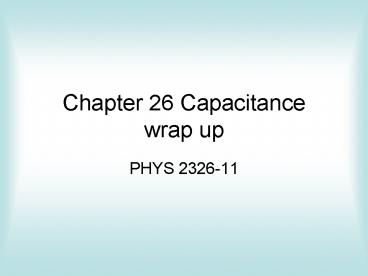Chapter 26 Capacitance wrap up PowerPoint PPT Presentation
1 / 17
Title: Chapter 26 Capacitance wrap up
1
Chapter 26 Capacitancewrap up
- PHYS 2326-11
2
Capacitance Review
- Capacitance C Q/?V
- Parallel plate capacitor C eo A/d
- Energy U ½ QV ½ C V2 Q2 /2C
- Energy density u ½ eo E2
- Dielectric (dialectric constant)
- C ?Co
- e ? eo
- E Eo/? s/?eo
3
Capacitance Review
- Circuits Series and Parallel
- Parallel capacitance adds since V the same,
qcv, cq/v - Series 1/Ct 1/C1 1/C2 .
- q is constant C1V1 C2V2
- 1/C1 V1/q, 1/C2 V2/q, 1/C3V3/q
- 1/Ct V1/q V2/q V/q
- 1/C 1/C1 1/C2 .
4
Example 2
- A parallel plate capacitor made from 2 squares of
metal, 2mm thick and 20cm on a side separated by
1mm with 1000V between them - Find
- a) capacitance b) charge per plate c) charge
density d) electric field e) energy stored f)
energy density
5
Example 2
- Given
- L 20cm 0.2m
- d 1mm 1E-3m
- V 1E3 V
- epsilon 8.85E-12 F/m
- Equations
- Ceo A/d, AL2 , QCV, s Q/A, V-Ed, U1/2
QV, u U/Ad 1/2 eo E2
6
Example 2
- a) C eo A/d (8.85E-12)(0.2 m)2/(1E-3 V)
0.354nF - b) QCV (0.354nF)(1E3 V) 0.354 µC
- c) s Q/A (0.354 µC)/(0.04 m2 ) 8.85E-6 C/
m2 - d) VEd, E V/d 1000/0.001 1.0E6 V/m (this
is a magnitude) - e) U (1/2)(0.354E-6)(1000)1.77E-4 J
- f) u (1/2)(8.85E-12)(1.0E6)2 4.425 J/m3
7
Chapter 27 Ohms Law
- PHYS 2326-12
8
Concepts to Know
- Current
- Drift Velocity
- Concentration of Particles
- Current Density
- Resistivity
- Resistance
- Temperature Coefficient of Resistivity
- Electric Power
9
Current
- Current is I dQ/dt Amperes A C/s
- Coulombs per second Amps Amperes
- This is charge passing through a point or surface
during time t - Uses positive charge for CONVENTIONAL current
flow (Same as electrons moving in opposite
direction)
10
Drift Velocity
- Microscopic model of charge is the flow of charge
carriers. - See Example 27.1 for drift speed of electrons
very very slow like 0.223 mm per second for
actual current flow - The electric field/voltage changes etc. is almost
the speed of light.
11
Current Density
- Current density is the current per unit area
traveling through a cross sectional area A. - J I/A Amperes/meter squared
- Valid for cross section perpendicular to the
direction of travel and for uniform current
density. - J s E where sigma is the conductivity of the
conducting material (not valid for all materials)
For those where valid Ohms Law
12
Ohms Law
- Jn q vd where n is the free electrons/m3 , vd
is the drift velocity and q is the charge per
electron, - I n q vd A where A is the cross sectional area
perpendicular to the current flow - V El when a small V is applied between the ends
of a wire of length l - J sE sV/l
- sigma is conductivity not charge density
13
Ohms Law
- ?V (l / s) J (l / (s A) ) I R I
- R ?V/I
- R resistance Ohm (O) 1 Volt/Ampere
- s conductivity 1/? (rho) resistivity
- R ? (l / A)
- bulk property increases with length, decreases
with cross sectional area - resistivity function of material and of
temperature
14
Resistors
- Resistors are components designed to have a
particular value. Typically, these have a color
code with value and multipliers. BBROYGBVGW is
0-9 or 1,10,100, . 109, Gold silver none are
5, 10 and 20 for the old ones. Standard
values are a bit odd as theyre based upon
accuracy ranges. Modern ones are typically 5 2
1 or better
15
Resistor Types
- Carbon film most common now
- Carbon composition becoming rare but is best
under surge conditions like nearby lightning - Other common types wire wound, precision metal
film - Platinum RTD (resistance temperature devices) are
very high precision temperature measurement
sensors.
16
Resistance Temperature Coefficient
- Resistivity
- ? ? o (1 a (T-To ) )
- a (alpha) is temperature coefficient of
resistivity - Since resistance is proportional to resistivity
- RRo (1 a (T-To ) )
Resistance schematic symbol
17
Electrical Power
- Power dissipation in a resistor
- dU/dt d/dt (Q?V) dQ/dt ?V I ?V
- U energy, I current
- Power P delivered to resistor I ?V
- Often E symbol used for V so we have PIE
- Using Ohms law IV/R
- P I2 R (?V) 2/R
- Power is Watts Joules / second

